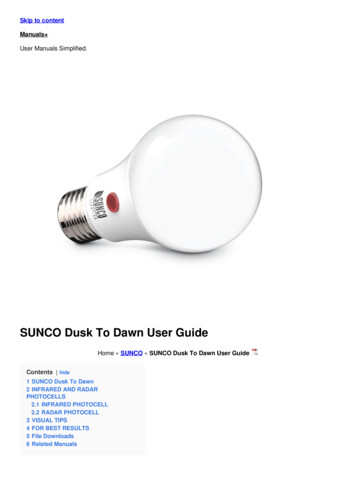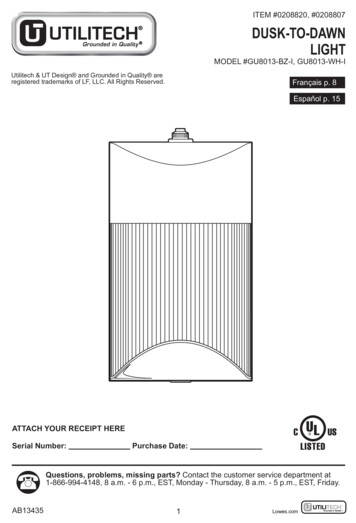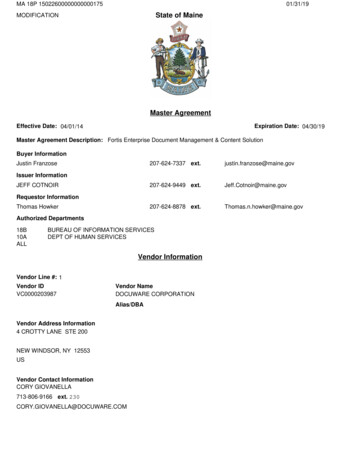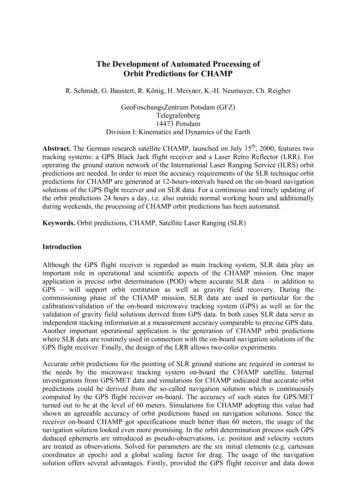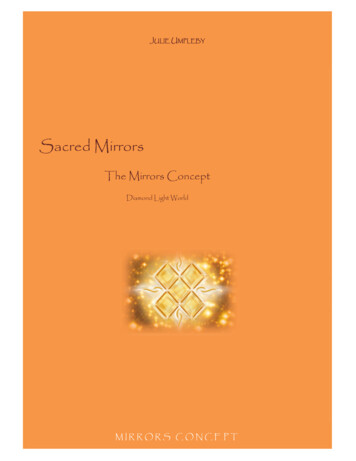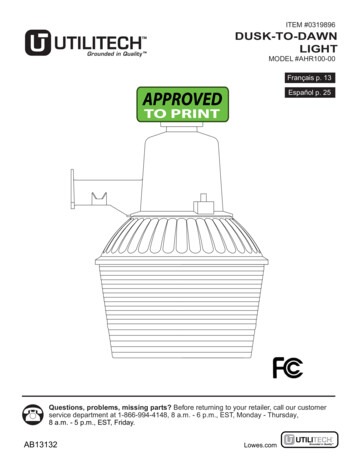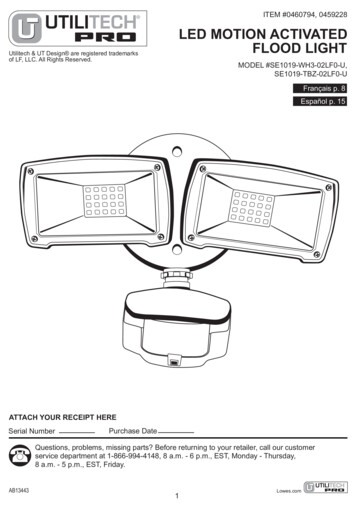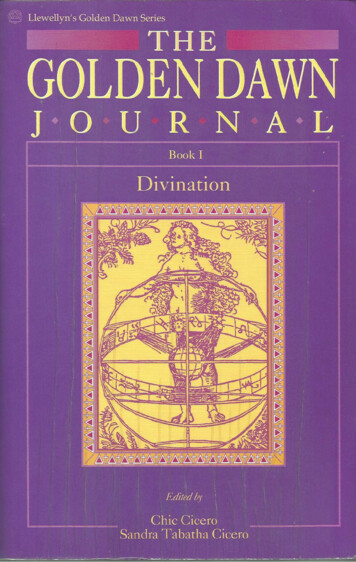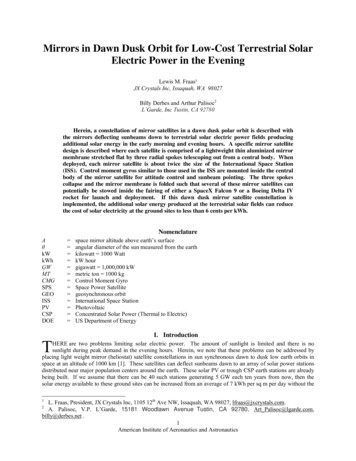
Transcription
Mirrors in Dawn Dusk Orbit for Low-Cost Terrestrial SolarElectric Power in the EveningLewis M. Fraas1JX Crystals Inc, Issaquah, WA 98027Billy Derbes and Arthur Palisoc2L’Garde, Inc Tustin, CA 92780Herein, a constellation of mirror satellites in a dawn dusk polar orbit is described withthe mirrors deflecting sunbeams down to terrestrial solar electric power fields producingadditional solar energy in the early morning and evening hours. A specific mirror satellitedesign is described where each satellite is comprised of a lightweight thin aluminized mirrormembrane stretched flat by three radial spokes telescoping out from a central body. Whendeployed, each mirror satellite is about twice the size of the International Space Station(ISS). Control moment gyros similar to those used in the ISS are mounted inside the centralbody of the mirror satellite for attitude control and sunbeam pointing. The three spokescollapse and the mirror membrane is folded such that several of these mirror satellites canpotentially be stowed inside the fairing of either a SpaceX Falcon 9 or a Boeing Delta IVrocket for launch and deployment. If this dawn dusk mirror satellite constellation isimplemented, the additional solar energy produced at the terrestrial solar fields can reducethe cost of solar electricity at the ground sites to less than 6 cents per kWh.NomenclatureAθkWkWhGWMTCMGSPSGEOISSPVCSPDOET space mirror altitude above earth’s surfaceangular diameter of the sun measured from the earthkilowatt 1000 WattkW hourgigawatt 1,000,000 kWmetric ton 1000 kgControl Moment GyroSpace Power Satellitegeosynchronous orbitInternational Space StationPhotovoltaicConcentrated Solar Power (Thermal to Electric)US Department of EnergyI. IntroductionHERE are two problems limiting solar electric power. The amount of sunlight is limited and there is nosunlight during peak demand in the evening hours. Herein, we note that these problems can be addressed byplacing light weight mirror (heliostat) satellite constellations in sun synchronous dawn to dusk low earth orbits inspace at an altitude of 1000 km [1]. These satellites can deflect sunbeams dawn to an array of solar power stationsdistributed near major population centers around the earth. These solar PV or trough CSP earth stations are alreadybeing built. If we assume that there can be 40 such stations generating 5 GW each ten years from now, then thesolar energy available to these ground sites can be increased from an average of 7 kWh per sq m per day without the1L. Fraas, President, JX Crystals Inc, 1105 12th Ave NW, Issaquah, WA 98027, lfraas@jxcrystals.com.A. Palisoc, V.P. L’Garde, 15181 Woodlawn Avenue Tustin, CA 92780, Art Palisoc@lgarde.com,billy@derbes.net .1American Institute of Aeronautics and Astronautics2
space mirrors to 12 kWh per sq m per day with the space mirrors. The additional 5 kWh per sq m per day will beprovided in the early morning and evening hours. See Fig. 1. The additional solar energy can reduce the cost ofsolar electricity at the ground sites to less than 6 cents per kWh. We shall explore this big and challenging idea 11 13 15 17 19 21 23TimeFigure 1: Deflected sun beams from mirrors in sun synchronous dawn to dust low earth orbit can provideadditional solar energy in early morning and evenings to ground solar electric power stations reducing thecost of solar electricity to 6 cents per kWh.II. BackgroundThe idea of using mirrors in space to beam sunlight down to earth for terrestrial solar electric power generationis not new. Dr. Krafft Ehricke first proposed this idea in 1978 as shown in figure 2 under the title Power Soletta [2].Because of the simplicity of mirrors compared to the complexity of the Space Power Satellite concept, his idea wasbrilliant particularly for the time in which it was first proposed.Specifically, Ehricke proposed a constellation of satellites in an orbit 4200 km in altitude beaming power downto a 1200 sq km site in Western Europe. Deflecting sunlight down to earth where it is then converted to electricityis conceptually much simpler than converting it to electricity in space and then microwave beaming it down to earthand then converting it to electricity as per the Solar Power Satellite [3] concept (figure 3).The key physical limitation for this concept relates to the size of the sun’s disc as viewed from earth. The sun’sdisc subtends an angle, θ, of 10 mrads. This means that the minimum size of a sun spot produced on the earth’ssurface from a mirror in space at an altitude, A, is:2A tan (θ/2)(1)Applying this formula for a mirror in orbit at an altitude of 4200 km gives a sun spot diameter on earth of 42 kmwith a corresponding area of 1385 sq km. This explains the 1200 sq km solar field size for the Power Solettaconcept. This also means that in order to produce an intensity of sunlight on earth equivalent to the normal daylightsun intensity, the area of the 3 mirrors shown beaming power down in Fig. 2 would have to be 1385 sq km and thearea of the 10 mirror satellites in the constellation in Fig. 2 would have to be 4617 sq km. Unfortunately, theenormous task of placing this mirror area in orbit was somewhat discouraging in 1978.In addition, there are two other problems with this concept as Ehricke proposed it. One problem is that thisorbit falls in the Van Allen radiation belt. A second problem will reside with the size of the earth solar electricpower field and the resulting problem of then distributing the power produced throughout Europe. Ehricke assumedthat the 1200 sq km solar field would produce electricity at 15% efficiency implying a 180 GW central power stationwhich then implies enormous distribution problems.While this Power Soletta concept was intriguing, given the problems just described, NASA has focused muchmore attention over the subsequent years on the Space Power Satellite (SPS) concept. A recent version (2003) ofthis SPS concept is shown in Fig. 3. This Integrated Symmetrical Concentrator (ISC SPS) concept [3] is of interesthere because it also utilizes mirrors. As shown in Fig. 3, in this concept, two sets of 36 mirrors with each mirrorapproximately 0.5 km in diameter are used to beam sunlight to a central PV converter platform that then generateselectricity and beams microwave energy to an earth generating station. This satellite is assumed to be located inGeosynchronous Orbit at an altitude of approximately 36,000 km. The special 8 km diameter earth receiver /generator station is assumed to generate 1.2 GW of electricity.2American Institute of Aeronautics and Astronautics
Figure 2: Power Soletta proposed by Dr. Krafft Ehricke [2]Figure 3: Integrated SymmetricalConcentrator Solar Power Satellite NASA [3].Dimensions: 5 km x 15 km.There are also problems with this ISC SPS concept. One problem is its complexity. More than just mirrors arenow required and it now no longer uses a potentially existing terrestrial solar electric power station.Within the context of mirrors in space, one promising feature associated with the ISC SPS design is theassumed use of 0.5 km diameter mirrors (figure 3). There are also other recent developments related to mirrors inspace. A Japanese Ikaros Solar Sail satellite is now en route to Venus and L’Garde [4] is now developing a verylightweight solar sail under a NASA contract (Fig. 4).Another promising recent development is the large and growing use of solar cells in terrestrial fields to generateelectricity. As of 2011, the total world wide solar electricity generation reached 65 GW and this is growing at a rateof 30% per year. At this rate, in 10 years, there should be 65 x (1.3)10 900 GW of PV in fields world wide.Furthermore, 5 GW terrestrial electric power stations are now already being built. (The Fukushima Daiichi NuclearPlant was a 4.7 GW power plant before its meltdown.)Figure 4: L’Garde 10,000 sq m Sunjammer [4] solar sail planned for launch in 2014 weighs 20 g/m2.3American Institute of Aeronautics and Astronautics
III. Preliminary Concept & Economic ArgumentOne problem for solar generated electricity is that the solar energy available to a 1-axis tracking solar powerstation on earth on average is only about 7 kW hours per m2 per day. With mirrors in space, sunlight can bepotentially provided during night time hours. However, a challenge is to invent a method whereby mirrors areprovided in space for night time solar electric power simply and affordably. Ehriche chose the mirror orbit at 4200km because he wanted to provide solar electric power all night. Is there another better orbit choice where themirrors can be utilized for 24 hours per day? For reference, figure 5a shows the concept of a sun synchronous orbitand figure 5b shows mirrors deflecting sunbeams down to earth.(a)(b)Figure 5: (a) Sun synchronous dawn to dusk orbit concept; (b) Mirrors deflecting sunbeams down to earth.Now imagine 18 mirror satellites in a sun synchronous orbit at an altitude of approximately 1000 km as shownin Fig. 6. There are several immediate benefits that result from this MiraSolar satellite constellation configuration.First, applying equation 1, the illuminated sunlight spot size on the earth is now only 10 km in diameter instead ofthe 42 km spot size associated with the Power Soletta configuration. Furthermore, the area of each mirror satellitenow required to produce a solar intensity equivalent to daylight sunlight is now only 78 sq km as well. This 10 kmmirror satellite size is comparable in size to the 5 km x 15 km ISC NASA SPS satellite size (75 sq km). As we haveshown in [1], the size of this earth based electric power station is now approximately 5 GW instead of the PowerSoletta sized 180 GW station.NFigure 6: A 18 mirror satellite constellation1000 km high is in a dawn/dusk sunsynchronous orbit around earth. North is up.The mirror satellites are evenly spaced inlatitude at the equator by 20 degrees.Figure 7: Three 18 mirror satellite constellations can bespaced in longitude as shown to provide an additional 3kWh/m2 per day each morning and 3 kWh/m2 per day eachevening. Thus, normal sunlight gives 8 kWh/m2 andbeamed sunlight gives an additional 6 kWh/m2.4American Institute of Aeronautics and Astronautics
Now assume this mirror satellite constellation will be available to an array of ground solar electric stationsdistributed around the world. As already noted, 10 years from now, there will be 900 GW of solar in the world. Allof this will not be in central power fields but if we assume that 1/3 of the 900 GW is or could be, then there will be300/5 60 available solar ground stations. These stations will be located in sunny parts of the world nearpopulation centers. Here, we shall assume that over the course of 24 hours as the world turns, 40 of the potential 60future sites depending on the weather for that day will be selected to receive additional sun beam energy in the earlymorning and early evening hours.Reference [1] discusses the 18 mirror satellite constellation in more detail. There are three key parameters: (1)The weight of each mirror satellite, (2) the energy delivered to a ground site by an 18 satellite constellation, and (3)the launch cost.Fortunately, the mirrors can be very light weight and there is a basis to project the mirror weight based onL’Garde’s NASA sponsored solar sail project. A weight of 20 g /m2 is justified and this yields a mirror satelliteweight of 1600 MT.In [1], it is shown that an 18 satellite constellation should provide an additional 2 kWh per m2 per day.Therefore, three 18 satellite constellations as shown in figure 7 should provide an additional 6 kWh/m2 per day (54mirror satellites in total).There are two projections for launch costs and it is assumed that these costs are the dominant cost elements. Anear term launch cost of 1100 per kg is based on an estimate by SpaceX [5] and a launch cost of 400 per kg isbased on a more frequent regular high rate launch program. Also, 400 per kg was assumed by NASA for their SPSstudy [3].Based on these key parameters, we estimate that the first 18 mirror satellite constellation will cost 32 B and thefollowing two constellations will cost 11 B each for a total cost of 54 B. While these numbers are high, they areactually quite low in terms of per W and this approach is definitely preferable to the microwave SPS systemproposed for GEO as shown in table I.From the point of view of the DOE Sun Shot program, the key question is the cost to benefit analysis. TheDOE states that the current road map price for solar electricity in 2020 is 9.1 cents per kWh and that the Sun Shotgoal is 6.1 cents per kWh [6]. Furthermore, the DOE goal for a solar system installed price in 2016 is 2.2 per W.Assuming /- 60 degree 1-axis EW tracking ground stations, then figure 7 shows 8 kWh/m2 per day of naturalsunlight and 6 kWh/m2 per day of mirror-deflected sunlight. Now assuming good sunny sites and assumingoccasional clouds, the numbers change to 7 and 5. Mirrors then provide 12/7 1.71 times more energy. The nextquestion is cost. The 220 GW of ground sites will cost 220 x 2.2 B 484 B and assuming the 1st 18 satellites cost 32 B given 1100 per kg but that the next 36 will cost 2 x 11 B because launch costs will be reduced. Then thecost penalty with added mirrors will be 538/484 1.11. Now accounting for more energy but at additional cost, thenet advantage is 1.54. Energy costs are then reduced to 9.1/1.54 5.9 cents per kWh.Table I: Space power system comparisonsParameterOrbit# SatellitesMirror Area per SatTotal Mirror Area24 hr/day EarthPowerCost ( 400/kg) per 24 h GWEarth Station SizeMiraSolar1,000 km1878 sq km1404 sq km220x2/24 18.3 GW 11 B 0.6 B/GW5.5 GWISC SPS36,000 km112.8 sq km12.8 sq km1.2 GW 14 B 11.7 B/GW1.2 GWIV. Developing a Lightweight Mirror Satellite DesignL’Garde has already published a size vs. weight study [2] for solar sails as summarized in Fig. 8. A 49,000 m2mirror area will correspond to a mirror diameter of approximately 250 m. We begin with a mirror element targetdiameter of 250 m. However, a solar sail mirror reflector does not need to be very flat. In the following, we presenta preliminary mirror element design concept and discuss some of the design trades.5American Institute of Aeronautics and Astronautics
Figure 8: Areal specific mass density projections for L’Garde solar sails as a function of sail area.In the previous section, we have described a mirror satellite constellation in a dawn dusk orbit deflectingsunlight down to earth sites for solar electric power production. However, the required mirror area is quite large.Each of the 18 mirror satellites has an area equivalent to the ground site area. That area is the area of a 10 kmdiameter spot, 78 sq km. So, it will be necessary to make up the required mirror area by using a large number ofsmaller mirrors. The size of these smaller mirrors needs to be defined such that they can be launched into spaceusing today’s launch vehicles. There is also a need for attitude control so that these mirrors can be pointed at theappropriate terrestrial sites. The required pointing mechanism must also be able to track and maintain the sun on thetarget site for an appropriate time interval. The mirrors need to be flat in order to create a required target beam withminimal divergence. Furthermore, it is desirable that these mirrors be efficiently stowed in a launch vehicle fairingin a configuration such that they can then be deployed in space for operation in space.Figure 9 shows a 2D drawing of the basic space mirror concept. As in Fig. 5b, the mirror satellites are shownorbiting the earth in a dawn dusk polar orbit deflecting sunlight down to the earth. The mirror satellites are shownas very much bigger relative to the earth than they really are in order to convey the concept. The velocity vectors forthe satellites in Fig. 9 are perpendicular to the page.SunlightEarthNFigure 9: Sunbeam deflecting mirror satellites orbiting the earth.The first problem is to decide on the appropriate mirror satellite size understanding that once one satellite can bebuilt, it can then be replicated in the number required to complete a given mission. The appropriate size chosenhere originates by reference to the International Space Station as well as by reference to today’s large launchvehicles.6American Institute of Aeronautics and Astronautics
The ISS size is approximately 109 m x 80 m and it weighs approximately 450 MT. Its moment of inertia isapproximately 2 x 10 8 kgm2.The fairing allowed cargo dimensions for the SpaceX Falcon 9 are 4.6 m diameter by 6.6 m long and the allowedcargo dimensions for the Boeing Delta IV H are 5 m diameter by 13 m long.Figure 10 shows a specific mirror embodiment as it will appear once deployed in space.UnmetalizedCircular Area atCenter of Mirror Figure 10: Deployed mirror satellite.The membrane mirror is stretched to a triangular configuration by loads F at each of the 3 verticesassuring a planar structure – 3 points define a plane in space The catenary edges (circular arc) result in an isotensoid stress state within the membrane The tripod booms are telescoping boomsThis mirror satellite consists of a triangular mirror with an edge dimension of 307 m. The triangularconfiguration was chosen because it can be supported with three booms with springs at the ends of the boom at threepoints then defining a plane. The springs will stretch the 2.5 micron thick mirror membranes flat. The edgedimension was chosen to provide a mirror area approximately equivalent to a 250 m diameter mirror which is about2.5 times larger in linear dimension than the largest dimension for the ISS. It is also half the diameter of the mirrorsin the NASA SPS design of figure 3. The booms are supported by a center body which will contain the attitudecontrol and communication systems for the mirror satellite. The mirror membrane segments attach at the center to aring floating above the center satellite body.Table 2 shows an preliminary estimate for the weights for the key elements for this mirror satellite. The weightestimate sums up to approximately 1.25 metric tons (MT). One can also estimate the moment of inertia for a 250 mdiameter mirror and the result is approximately 4 x 10 6 kgm2.Table 2: Estimated weight for the Mirror Satellite shown in figure 10.Membrane:Membrane thickness: 2.5 microns(DuPont is willing to dodevelopment to make2.5 micron thick Kapton)Length of side of triangle: 306mMass density of membrane:1384 kg/m 3Mass of membrane w/o seams:140.5 kgSeam mass (5% of membrane): 7 kg.Total membrane mass: 148 kgBooms:Mirror Satellite:Length of a boom: 177 mWall thickness:0.015 inch 3.8e-4mAverage diameter:0.76m 30 inchesMass density: 1400 kg/m 3Mass of one boom: 226kgMass of end fitting (5%): 11 kgMass of CMG (ISS): 98kgMass of membrane 3 booms 4 CMGs: 1,251 kgContingency (10%): 125 kgEstimated Grand Total Massof 1 Mirror Satellite: 1,376 kgMass of 3 booms: 711 kg7American Institute of Aeronautics and Astronautics
The two key problems are attitude control and compact stowage in a launch vehicle fairing. Figures 11 shows asolution for the attitude control problem and Fig. 12 shows a solution for the compact stowage problem in a launchvehicle.Figure11Figure 11 shows the control moment gyros (CMGs) used for attitude control in the International Space Station [7].These control moment gyros are each approximately 1 m in diameter and they are capable of slewing the mirrorsatellite of Fig. 2 through an angle of 45 degrees in 5 minutes.Figure 12 shows CMGs in the body of the mirror satellite of Fig. 10 but the mirror satellite has now been foldedup into a very compact form. The CMGs are housed in a structurally-capable "spacecraft bus" (not shown) whichallows the spacecraft attitude pointing. The folded spacecraft outer dimension is 4.6 m and its height is 3 m. Two ofthese stowed mirror satellites could be launched into orbit by a Falcon 9 and four could be launched by a Delta IV Hrocket.Figure 12: Mirror satellite in stowed configuration.Note top solar panel for power on left and CMGs in body on right.Referring to Fig. 12, notice that the 3 beams have been telescoped in and rotated 90 degrees so that they now laybeside the satellite body. The thin mirror membranes have been folded in so that they lay against the satellite body8American Institute of Aeronautics and Astronautics
and between the beams. For deployment once in orbit as shown in Fig. 13, the beams rotate and telescope out andthe mirror membrane unfolds and then gets stretched flat by the springs at the ends of the beams.Figure 13: Deployment sequence.Figure 14 shows one possible concept for folding the thin mirror membrane for stowing and figure 15 shows howthe booms can be formed and deployed.Figure 14: A potential mirror fold pattern [8].9American Institute of Aeronautics and Astronautics
Figure 15: Above- Telescoping boom concept.Right - Snapshots at different times of thedeployment of example conical (telescoping)boom. This particular boom has a basediameter of 16 cm and a tip diameter of 15.9cm. The boom length is 2.5m. Tube wallthickness is 0.2032 mm.Given the mirror satellite design in Figs. 10, 12 and 13, these mirror satellites then can be deployed inconstellations. For the solar power fields, a string of 18x1600 mirror satellites would be required to circle the earthin order to create 1-sun intensity at the solar power field ground sites. For an orbit 1000 km above the surface of theearth, the orbit circumference will be approximately 3.14 x 14,700 km 46,160 km. Thus the 28,800 mirrorsatellites if evenly spaced in a ring would then be spaced by approximately 46,160/28,800 1.6 km apart.Because this is a very large number, one might imagine starting with a constellation of 20 of these mirrorsatellites in order to create less intense light for downtown city areas around the world displacing the electricityrequired for street lights at night. Table 3 summarizes this idea and shows a potential pay back time of 4.5 years.These 20 satellites could be placed in orbit with 5 Delta IV H launches.Table 3: Economics for Space Mirror Sun-Beam Street LightingSun Beam SizeBeam Intensity 250 m diameter space mirrorStreet Light LampStreet Light Density in ManhattanElectric Power Equivalent per sunbeam siteAssume 2 h morning 2 h evening per dayElectric Energy per site per yearAssume 0.1 per kWhFor 4 sites in US (Miami, Dallas, Denver, LA)For 40 downtown sites around the worldCost to orbit with SpaceX Falcon [9]Cost for 20 Mirror Sats at 1 MT per Mirror SatPay back time for 20 Satellites and 40 sites40 sq miles62 lumens per m2 (62 lux)100 W and 20 lux633 per sq mile633x40x100 2.53 MW4x365 1,460 hrs per year3.7 GWhrs per site per year 0.37 million per site per year 1.5 million per year 15 million per year 3,400 per kg or 3.4 million per MT [9] 68 million4.5 yearsV. Summary and ConclusionThe work described here actually began with a dream of a Space Power Satellite capable of providing solarelectric power economically for 24 hours per day. However, we have noted that the SPS concept is simply toocomplex since it assumes multiple energy conversion steps and includes special constructed ground microwave10American Institute of Aeronautics and Astronautics
receiver stations. We then observed that mirrors deflecting sunbeams down to earth would be a much simplerconcept. We then noted that there could be a surprising convergence of two technologies under development, i.e.lower cost access to space and the ongoing construction of larger and larger solar power fields around the world.Further analysis of mirrors in space in a dawn dusk orbit combined with future solar power fields has shown thisidea to be actually a potentially viable economical proposition. The projected cost of this proposition of 11 billionactually appears to be comparable to the projected cost of the SPS concept at 14 billion while producing an order ofmagnitude more solar energy (Table 1).However, while this idea is very intriguing, the magnitude of its implementation is daunting. Nevertheless, theidea is intriguing enough to proceed with a first order design for the required mirror satellites. A mirror satellitedesign has been presented here. It builds from mirror technology for solar sails at L’Garde as well as technologydeveloped for the International Space Station. It appears that the technology is available to implement this mirrorsatellite design and at least go to a detailed design and test stage. Furthermore, we observe that there is a smallerless expensive ( 68 million) initial practical application for these mirror satellites in providing nighttimeillumination for inner cites avoiding the need for electric power for street lights in the early morning and eveninghours.Given all of the above, there is still another non-technical difference between the dawn dusk space mirrorconcept and the initial SPS concept and that difference is in perspective. The dawn dusk space mirror conceptrequires a global perspective and international cooperation whereas the SPS concept is based on a traditionalnational perspective. In this regard, the International Space Station does provide hope for future internationalcooperation.In the end, the concepts presented here do contribute to the dream for economical renewable energy for theworld in the future. However, as is already the case, the completion of this dream is more of a political problemthan a technical problem and will require leadership and vision as was demonstrated by President John F. Kennedywhen he launched the Apollo Program.References[1] L. M. Fraas, “Mirrors in Space for Low Cost Terrestrial Solar Electric Power at Night”, Photovoltaic SpecialistsConference (PVSC), 2012 38th IEEE (June 3-8 lications/PVSC 38 Manuscript Fraas 5-9-12.pdf[2] K. A. Ehricke, The Extraterrestrial s/aureview/./ehricke.html[3] H Feingold & C Carrington, 2002, "Evaluation and Comparison of Space Solar Power Concepts" 53rdInternational Astronautical Congress[4] http://www.lgarde.com/papers/2003-4659.pdf[5] Elon Musk, "Space Shuttle and the Future of Space Launch Vehicles," Senate Committee on Commerce,Science, and Transportation, May 5, 2004.[6] http://www1.eere.energy.gov/solar/pdfs/csp sunshot 2011march ramamoorthy.pdf, Slide 26[7] INTERNATIONAL SPACE STATION - NASAwww.nasa.gov/pdf/508318main ISS ref guide nov2010.pdf[8] Natori, et. al., “Membrane Mod. Space Struct. Systems .”, AIAA-2010-2909.[9] http://en.wikipedia.org/wiki/Comparison of orbital launch systems11American Institute of Aeronautics and Astronautics
sunlight during peak demand in the evening hours. Herein, we note that these problems can be addressed by placing light weight mirror (heliostat) satellite constellations in sun synchronous dawn to dusk low earth orbits in space at an altitude of 1000 km [1]. These satellites can deflect sunbeams dawn to an array of solar power stations
